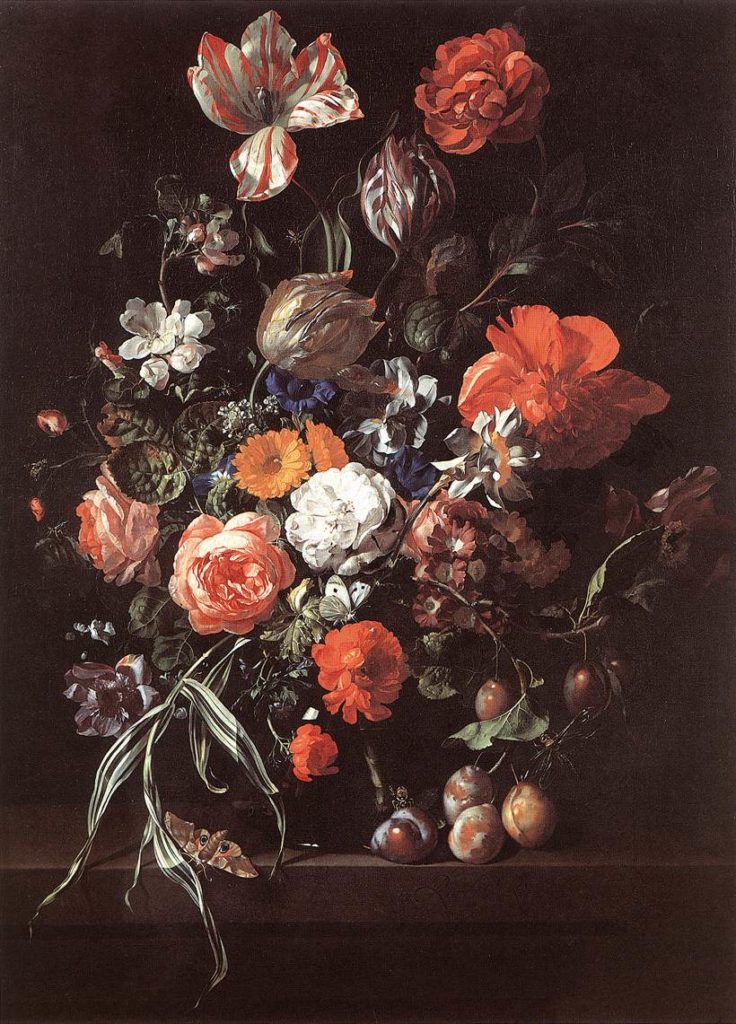Tulips in Art
Like all flowers, the tulip may communicate various meanings in works of art.

Beauty and Wealth
Flowers are cultivated for their beauty, but a bloom’s presence in art may not only enhance the visual appeal of the work, but can also convey a deeper meaning.
The earliest known example of tulips in visual art appears on a 13th century tile from the Turkish palace of Alāad-Dīn Kayqubād bin Kaykāvūs. Its presence in the Sultan’s home associated the tulip with wealth, power, and fame – meanings that the flower would continue to convey for centuries. In art from the Ottoman Empire, we find images of tulips painted onto decorative ceramics, woven into carpets, and embroidered onto the garments of the elite.
As tulips gained popularity in Europe in the 1600s, a similar association played out as the Dutch became one of the wealthiest nations with a growing merchant class that could afford new luxuries. A new market developed for art that depicted subjects beyond traditional religious themes, at the same time that a new interest in exotic plants and flowers spurred the tulip market. Tulipmania happened in the middle of what is known as the Dutch Golden Era of painting, a convergence that brings us many examples of exquisitely depicted tulips.
Image: “Still-Life with Bouquet of Flowers and Plums” painted by Rachel Ruysch in 1704.

Still Life
Still life paintings emerged as one of the popular new forms of secular art, including a subgenre called Pronkstillevens or “ostentatious” still life paintings. The diversity of fruits and flowers was meant to convey the wealth and worldliness of the depicted interior, and these same qualities could similarly be conferred upon the interior where the painting would be displayed. Arrangements of flowers frequently included tulips, like in the painting by Johannes Bosschaert shown here. The most expensive flower (often a tulip) would usually be painted with the highest and most prominent position in a floral arrangement, like the Semper augustus depicted in Hans Gillisz’s painting.
Still life subjects in Dutch Golden Era paintings often also have a moral message to convey. These vanitas paintings are ostensibly meant to function as a reminder of the fleetingness of life, the folly of worldly pursuits, and the impermanence of beauty. The tulip’s fragile bloom is meant to remind us that we too will wither away, yet at the same time the sumptuous and lifelike depictions offer beauty in their own right. The moral message is mixed with the enjoyment of the artist’s mastery of the form.
Perhaps the most acclaimed tulip and flower painter of the Dutch Golden Era was Rachel Ruysch. Not only could her works command prices of up to 1,200 guilders, but she was the first woman to become a member of the exclusive fraternity of artists called the Confrerie Pictura in the Hague. In her hundreds of minutely detailed paintings, she developed a style that captured the tiny imperfections of nature, resulting in the most subtle reminder that all things must eventually fade away.
There also are much more explicit warnings in the art from this era about betting on bulbs, following the collapse of Holland’s tulip market in 1637. Hendrik Gerritsz Pot’s “Wagon of Fools” and Jan Brueghel the Younger’s “A Satire of Tulip Mania” both portray flower speculators as immoral, stupid, and drunk. Surrounded by anthropomorphized monkeys, the tulips in Jan Brueghel’s painting need only to represent themselves. In Gerritsz Pot’s allegorical painting, the tulips also adorn motley caps, making the scene even more ridiculous.
As tulips became more widely commercialized and the cost of tulips became more affordable, new meanings also proliferated. In the complex language of flowers that became popular in Victorian England, tulips took on many more meanings. Many of the dictionaries of flowers reiterate that red tulips in particular communicate a declaration of love, including Henry Philip’s “Floral Emblems” and Robert Tyas’ “The Sentiment of Flowers.” In Frederic Shoberl’s “The Language of Flowers,” published in 1834, tulips are also said to have symbolized “complaints of infidelity.” Shoberl further writes, “this flower has been considered as an appropriate symbol of a female who possesses no other recommendation other than personal beauty.”
Different ideas have become attached to specific colors of tulips – often corresponding to the cultural meanings associated with those colors themselves. For example, white tulips became associated with forgiveness and purity, purple flowers may be associated with royalty. A bouquet of pink tulips may have meant to convey friendship and caring.
However, perhaps the most universal messages that can be understood from images of plants are about time and place. Flowers retain some connection to the specific seasons and places where they flourish. Tulips often communicate springtime in art, and the reemergence of greenery and blooms after a cold winter. From there, we may interpret them as a symbol of rebirth or youth.
Today, for many North Americans and Europeans, tulips are most closely associated with Holland, the nation that dominates the global bulb trade, and images of tulips may trigger associations with Dutch culture as readily as windmills or wooden clogs. At the same time, they are also an important part of the legacy of the Ottoman Empire and the heritage of the region it covered, and today the tulip is still an important symbol in that region as well. In Iran, it’s the national symbol of martyrdom. In Turkish, the word for tulip contains the same letters as the word Allah, elevating the tulip to a holy symbol. In art from the region where this flower was first cultivated, the tulip can serve as a reminder of the divine.
